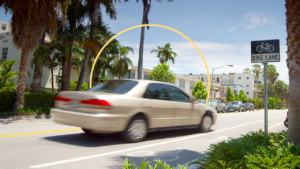How does your car make and model impact your insurance rates?




Your cost of car insurance depends on more than a dozen individual rating factors, but the make and model of car you drive is a big one. From speed and engine size to trim level, tech features and overall safety, the car you drive has complex impacts on your auto insurance rates.
What is a car make?
A car’s make is the company or brand that manufactures the car, such as Ford, Nissan, Honda, GMC or Toyota. Some manufacturers own and produce multiple makes. For instance, the Honda Motor Company owns both Acura and Honda. Acura is the company’s luxury division while Honda is its mass market counterpart, but these are two separate makes.
What is a car model?
A car’s model is the specific product line that the manufacturer sells. In the case of a Honda Civic, the make is Honda, and the model is a Civic. With a Tesla Model S, Tesla is the make, and Model S is the model.
A vehicle model typically has several variations, known as trims, which may offer additional equipment and comfort perks. For instance, the Toyota RAV4 is available in six trim levels: LE, XLE, XLE Premium, Adventure, TRD Off-Road and Limited. The LE is the base trim, which is the most affordable version of this model and has the fewest upgrades; the TRD Off-Road and Limited are the most expensive and come with a suite of performance improvements and premium features.
How does a car’s make and model affect insurance rates?
The most obvious way that your vehicle’s make and model affect the cost of car insurance comes down to market value. If you have full coverage on your car, its market value — that is, the cost to repair or replace that make and model — will be a major factor in the cost to insure it. More valuable or expensive vehicles are typically more expensive to insure.
But the impact of make and model on insurance goes beyond value — and your vehicle type can affect your rates even if you’re not buying physical damage coverage. Ben Preston, auto writer for Consumer Reports, says that thinking about insurance during the car buying process can improve your odds of paying a reasonable rate: “Vehicle type is a factor in how much you’ll pay for car insurance, so you’ll want to choose wisely to avoid premium shock.” In order to do that, it’s important to understand what insurers look for in a car.
Age of vehicle
The newer the car, the more expensive the insurance — in most cases. This is based on the vehicle’s replacement cost. A newer vehicle would typically cost more for an insurance company to replace than an older vehicle. Additionally, newer vehicles are likely to have more complex features or electrical components, which may also drive up repair costs.
Some exceptions to that rule include classic or rare cars, which may cost more to insure than their newer counterparts and may even require a specialized insurance policy. You may also pay less to insure a new car if you work with a company that offers discounts for new vehicles. Typically, a car needs to be three years old or newer to qualify for these discounts.
Size of vehicle
The bigger and heavier the construction of a vehicle, the more it may cost to insure, because big cars, such as SUVs and large pickup trucks, can cause more damage. Additionally, small cars generally pose less of a risk to other vehicles on the road in accidents than standard vehicles might, often resulting in less expensive premiums.
Research by the Insurance Institute for Highway Safety (IIHS) found that insurance losses from third-party property damage claims were 8 percent lower for small SUVs like the Honda CR-V and Hyundai Santa Fe compared to the average for all private passenger vehicles. For large SUVs like the Ford Expedition, property damage claims were 2 percent above the industry average, and for large pickups, such as the Chevy Silverado and Ford F-150, property damage losses were 16 percent above the industry average.
Conversely, however, larger vehicles may also provide better crash protection during an accident compared to smaller, lighter cars. This can mean reduced medical costs associated with an accident claim.
Trim level
Sunroofs, leather interiors, sound systems, Bluetooth and internet connectivity can make driving more enjoyable and convenient, but they also might add to your insurance premium. Opting for the base trim of any model may net you the lowest insurance rates because your insurer doesn’t need to cover additional equipment that drives up your repair costs. Replacement costs are also generally lower for these simpler models.
However, some trims include practical upgrades, such as a higher level of collision mitigation technology, which could offset the insurance cost of those non-essential perks. Comparing rates for a few trim levels could help you estimate your potential insurance costs before buying a vehicle.
Theft rates
If you have comprehensive coverage on your vehicle, the likelihood of your vehicle being stolen may factor into the price you pay for coverage. According to the National Insurance Crime Bureau (NICB), Hyundai and Kia models made up 60 percent of the top 10 auto theft targets in 2023 — and as result, many insurers are charging higher rates or even denying coverage for Hyundai and Kia vehicles that are not equipped with engine immobilizers.
Engine size and performance capabilities
Insurance companies try to base rates in part on how you drive — and some vehicles are designed for more risky driving. A high-performance vehicle engineered for speed is more likely to be in accidents compared to a minivan designed to safely transport kids to soccer practice. Engine size is one indicator of vehicle performance that insurers may look at when estimating your premiums, with higher rates assigned to more powerful vehicles.
Vehicle performance may also be linked to anticipated driver behavior. “Insuring a high-powered sports car, for example, is typically going to cost more than insuring a Toyota Camry,” Preston says, “because owners of those cars often exhibit riskier behavior, and those cars are also more likely to be stolen.”
Safety features
Car insurance companies typically charge lower premiums for vehicles with certain safety features because they reduce the risk of accidents and may better protect occupants in the event of a collision. Additionally, some safety features may reduce the chance of theft or even deter vandalism. Insurance providers often look at safety features like electronic stability control, anti-lock brakes, anti-theft systems and curtain airbags.
Electric vehicles
Although advances in electric technology have started to close the gap, EVs still cost more to insure than standard gas-powered vehicles.
Preston explains: “They are still the relatively new kids on the block, so insurers don’t have as much longstanding risk assessment data for EVs as they do for other vehicles and have to price uncertainty into their premiums. EVs are also more likely to be totaled after an accident than other car types and are expensive to repair.” In 2023, electric vehicles made up just 1.5 percent of all private passenger vehicles, but were responsible for 2.3 percent of the total claims payment amount for all vehicles, according to the 2024 Auto Insurance Trends Report from LexisNexis Risk Solutions.
What makes and models cost the least to insure?
In general, small or midsize SUVs from mass-market manufacturers with strong safety ratings will be cheapest to insure based on make and model.
The Subaru Outback, for example, costs roughly 27 percent less to insure than the national average cost of car insurance, according to average premium data from Quadrant Information Services. The 2022 Subaru Outback — the exact model our data looks at — was an IIHS Top Safety Pick+, with top safety ratings in every category studied. It’s also one of the more affordable SUVs on the market, with a starting MSRP under $30,000 for 2022 models.
Honda, Toyota and Ford produce some of the other cheapest models to insure. The following 2022 models are among the cheapest to insure compared to the national average of $2,311 per year for full coverage insurance:
- Subaru Outback: $1,818 per year
- Honda CR-V: $2,116 per year
- Toyota RAV4: $2,138 per year
- Ford F-150: $2,163 per year
- Ford Escape: $2,204 per year
- Honda Civic: $2,277 per year
How to get quotes for your make and model
You can generally get quotes for your make and model over the phone, in person or online. If the carrier you’re interested in offers online rates, here are the steps you can take to get quotes online:
- Visit the insurance company’s website.
- Find the option to request a quote online.
- Enter the requested personal information, such as your full name, date of birth and driver’s license number.
- Enter the same information for any household drivers.
- Enter your vehicle information, including year, make, model, VIN and mileage.
- Select your coverage choices.
- Receive quote.
Getting several quotes from different carriers may help you find the best rate for your make and model. Some carriers don’t offer online quoting. Working with a local agent or insurance broker may help you explore all your options for insurance pricing.
Frequently asked questions
Methodology
Bankrate utilizes Quadrant Information Services to analyze June 2024 rates for all ZIP codes and carriers in all 50 states and Washington, D.C. Rates are weighted based on the population density in each geographic region. Quoted rates are based on a single, 40-year-old male and female driver with a clean driving record, good credit and the following full coverage limits:
- $100,000 bodily injury liability per person
- $300,000 bodily injury liability per accident
- $50,000 property damage liability per accident
- $100,000 uninsured motorist bodily injury per person
- $300,000 uninsured motorist bodily injury per accident
- $500 collision deductible
- $500 comprehensive deductible
To determine minimum coverage limits, Bankrate used minimum coverage that meets each state’s requirements. Our base profile drivers own a 2022 Toyota Camry, commute five days a week and drive 12,000 miles annually.
These are sample rates and should only be used for comparative purposes.
Model: To determine cost by vehicle type, we evaluated our base profile with the following vehicles applied: Ford Escape, Ford F-150, Honda Civic, Honda CR-V, Toyota RAV4, Subaru Outback and Toyota Camry (base).
Why we ask for feedback Your feedback helps us improve our content and services. It takes less than a minute to complete.
Your responses are anonymous and will only be used for improving our website.
You may also like

What is the actual cash value of my car?

How a speeding ticket affects insurance in Florida

How do deductibles impact your car insurance?

